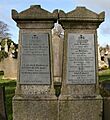James Clarence Mangan facts for kids

James Clarence Mangan (born James Mangan) was an important Irish poet. He was born in Dublin, Ireland, on May 1, 1803, and passed away on June 20, 1849.
Mangan was known for translating poems from many languages, including German, Turkish, Persian, Arabic, and Irish. His translations of German poet Goethe were especially popular. Later in his life, especially after the Great Famine began, he wrote many poems about Irish pride and history. One famous example is A Vision of Connaught in the Thirteenth Century.
He died at a young age due to illness during the difficult time of the Famine. After he passed away, many people saw Mangan as Ireland's first national poet. Famous writers like James Joyce and William Butler Yeats admired his work greatly.
Growing Up in Dublin
James Mangan was born in Fishamble Street, Dublin. His father, also named James Mangan, used to be a teacher and later ran a grocery store. His mother, Catherine Smith, was from Kiltale, County Meath. The family business faced difficulties and eventually went bankrupt.
James Mangan's early life is not fully clear because records were not kept well. Also, Mangan himself sometimes wrote about his past in a dramatic way. Even though some people thought he was always poor, it seems he grew up in a comfortable middle-class home.
He went to a Jesuit school where he learned several languages, including Latin, Spanish, French, and Italian. He attended three different schools before he was fifteen years old. To help his family, he started working at a young age. He worked as a clerk for seven years and later in a lawyer's office. He also worked for the Ordnance Survey and in the library at Trinity College, Dublin.
Mangan's Writing Journey
James Mangan's first poems were printed in 1818. Around 1820, he started using "Clarence" as his middle name. By 1830, he began translating poems from German, a language he taught himself. His versions of Goethe's poems were very interesting.
From 1834, his writings often appeared in the Dublin University Magazine. In 1840, he started translating from Turkish poetry, Persian poetry, Arabic poetry, and Irish poetry. Mangan was also known for playing tricks with his writing. Some of his "translations" were actually poems he wrote himself! He called this "reverse plagiarism." One example is Twenty Golden Years Ago, which he said was by someone named Selber.
Mangan became friends with patriotic journalists Thomas Davis and John Mitchel. Mitchel later wrote about Mangan's life. Mangan's poems were published in their newspaper, The Nation. He even received a regular payment for a while. However, his work habits sometimes made it hard for him to keep these arrangements. Still, he continued to send poems to The Nation.
After the Famine, Mangan began writing more patriotic poems. These included important works like Dark Rosaleen, which was his version of the old Irish song Róisín Dubh. Another famous poem was A Vision of Connaught in the Thirteenth Century.
Some of his most well-known poems are Dark Rosaleen, Siberia, Nameless One, and Woman of Three Cows. He also started writing a short story about his own life. This story was written near the end of his life and stops in the middle of a sentence.
Mangan's Poetic Style
Mangan's poetry fits into several different writing styles. Many people read his work alongside other Irish nationalist writers like John Mitchel. Their poems appeared in newspapers like The Nation and The United Irishman. His work also shows the spirit of the 19th-century Irish Cultural Revival. Many of Mangan's poems, like Dark Rosaleen, seem to be new versions of older translations rather than completely new ones.
Mangan is often seen as a Romantic poet. People compare him to writers like Samuel Taylor Coleridge. This is partly because he sometimes wrote about visions or dreams in his poems.
More recently, some experts have started to see Mangan's work as an early example of modern and postmodern experimental writing. His playful tricks, like making up "fake" translations, are now seen as similar to the works of later writers like Flann O'Brien.
Images for kids


